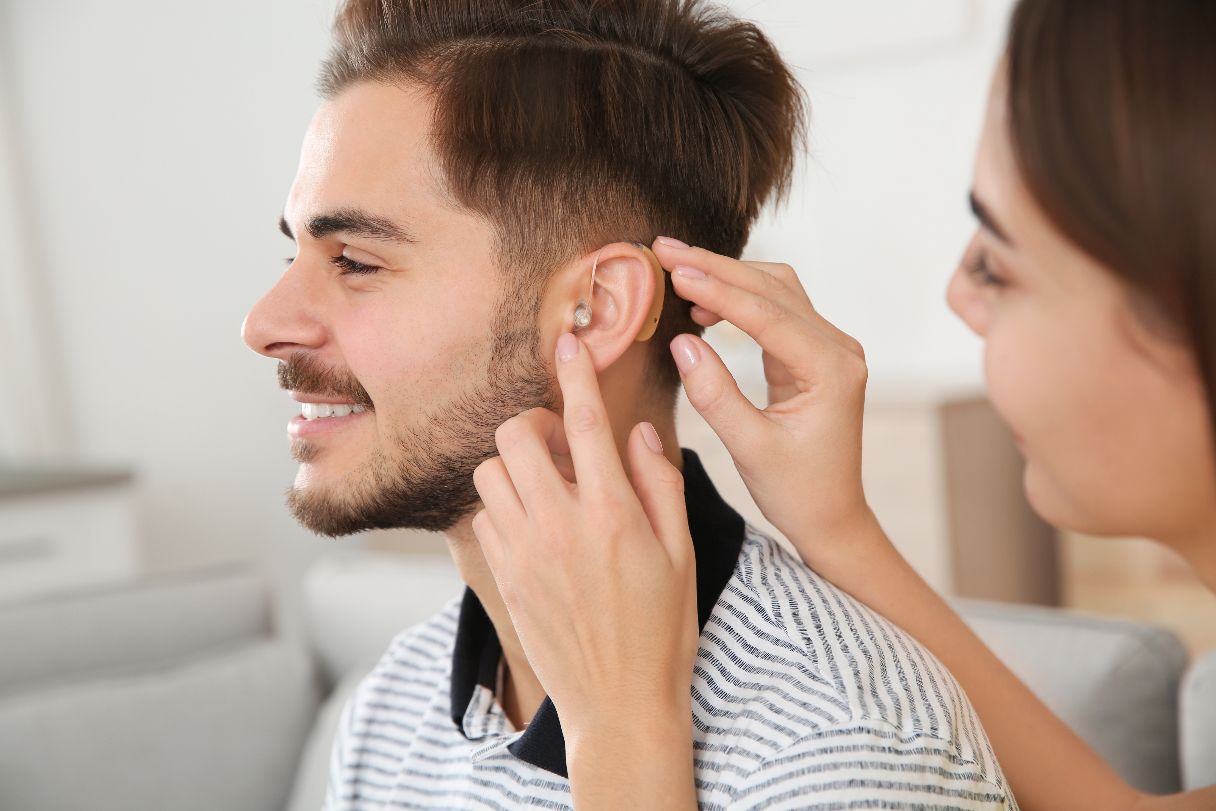Hearing loss can significantly affect a person’s quality of life, and while hearing aids and cochlear implants are effective for many, they may not work for those with certain conditions. For people with profound hearing loss who cannot benefit from traditional hearing solutions, auditory brainstem implants (ABIs) offer an alternative that bypasses damaged or absent auditory nerves, potentially providing the ability to perceive sound.1
Read Related Articles
15 Tips to Improve Your Hearing and Prevent Hearing Loss
How to Cope With Hearing Loss: 6 Helpful Strategies
What Is an Auditory Brainstem Implant?
An auditory brainstem implant is a surgically implanted medical device designed to provide hearing sensations to patients with severe-to-profound hearing loss caused by auditory nerve damage, malformation or absence at birth.1 Unlike cochlear implants, which stimulate the auditory nerve, ABIs bypass the inner ear and damaged or absent auditory nerve and instead stimulate the cochlear nucleus (hearing pathway) directly.2
What Does an ABI Treat?
ABIs are most commonly recommended for patients with conditions such as:1
- Congenital or acquired deafness due to cochlear or auditory nerve malformations that make cochlear implants ineffective
- Neurofibromatosis type 2 (NF2), a rare genetic disorder characterized by tumors on the auditory nerves
- Severe inner ear damage resulting from trauma, infection or the surgical removal of tumors2
Auditory Brainstem Implant Cost
The national average cost* of auditory brainstem implants in the United States is $55,869 but can range from $43,659 to $107,261. The final price may be affected by the device costs, specialist consultation fees and postsurgery rehabilitation and therapy.3
Auditory brainstem implant cost by state/district
Below is a look at the average cost* of auditory brainstem implants across all 50 states and the District of Columbia:3
| State/District | Average cost |
|---|---|
| Alabama | $48,390 |
| Alaska | $67,734 |
| Arizona | $56,415 |
| Arkansas | $49,708 |
| California | $70,250 |
| Colorado | $55,038 |
| Connecticut | $56,775 |
| Delaware | $55,697 |
| District of Columbia | $70,429 |
| Florida | $55,657 |
| Georgia | $50,666 |
| Hawaii | $80,670 |
| Idaho | $56,894 |
| Illinois | $52,942 |
| Indiana | $50,486 |
| Iowa | $47,372 |
| Kansas | $50,247 |
| Kentucky | $51,145 |
| Louisiana | $52,223 |
| Maine | $56,715 |
| Maryland | $67,255 |
| Massachusetts | $65,698 |
| Michigan | $51,325 |
| Minnesota | $52,523 |
| Mississippi | $47,492 |
| Missouri | $49,169 |
| Montana | $54,978 |
| Nebraska | $49,828 |
| Nevada | $55,936 |
| New Hampshire | $56,835 |
| New Jersey | $61,266 |
| New Mexico | $50,846 |
| New York | $60,608 |
| North Carolina | $51,564 |
| North Dakota | $51,205 |
| Ohio | $52,163 |
| Oklahoma | $48,390 |
| Oregon | $60,428 |
| Pennsylvania | $54,319 |
| Rhode Island | $58,272 |
| South Carolina | $52,403 |
| South Dakota | $50,007 |
| Tennessee | $50,965 |
| Texas | $52,043 |
| Utah | $55,218 |
| Vermont | $59,530 |
| Virginia | $54,679 |
| Washington | $62,045 |
| West Virginia | $50,307 |
| Wisconsin | $52,463 |
| Wyoming | $53,421 |
Does Health Insurance Cover Auditory Brainstem Implants?
Auditory brainstem implants are recognized as standard treatment for severe-to-profound nerve deafness, and as a result, the hearing implant procedure may be covered by most private medical insurance as well as Medicare, Medicaid, the Veteran's Administration and other public healthcare plans. Specific benefits may vary depending on your plan and coverage.4
How Does an ABI Work?
An auditory brainstem implant has two parts: an external processor worn on the ear and a surgically implanted receiver. An ABI bypasses the damaged or absent auditory nerve to restore some level of sound perception by directly stimulating the cochlear nucleus, a part of the brainstem that processes auditory information.2
Sounds from the environment are captured by a microphone and transmitted as electronic signals by an external sound processor, similar to those used in cochlear implants. The signals are sent to a receiver implanted under the skin behind the ear. The receiver transmits the signals to an electrode implanted on the cochlear nucleus, bypassing the damaged auditory nerve and directly stimulating the brainstem. The cochlear nucleus interprets the signals as sound, providing auditory sensations to the user.2
While results vary, many patients achieve improved sound awareness and lipreading ability after an ABI procedure.5 Some may achieve sound, word and sentence recognition.1 This can be similar to the results of patients who receive cochlear implants.6
ABI vs. Cochlear Implant
While both ABIs and cochlear implants aim to provide a deaf person with the sensation or representation of sound, neither device restores normal hearing.6 Auditory brainstem and cochlear implants work differently to create a perception of environmental sounds.
- Cochlear implants are designed for hearing loss patients with functioning auditory nerves and intact cochlea structures. The device stimulates the cochlear nerve directly, providing auditory signals to the brain.7
- Auditory brainstem implants are often used for patients with non-functioning auditory nerves who cannot benefit from cochlear implants, such as those with neurofibromatosis type 2 or auditory nerve aplasia. ABIs bypass the auditory nerve and stimulate the cochlear nucleus directly in the brainstem.7
Extensive rehabilitation and training with an interprofessional team that can include an audiologist, speech-language pathologist, neurotologist and otologist are often required to maximize the benefits of ABIs, as with cochlear implants.8
Who Is a Good Candidate for an ABI?
Patients with profound sensorineural hearing loss (hearing loss that occurs when the inner ear or nerve pathways to the brain are damaged), hearing loss due to neurofibromatosis type 2 or patients with irreversible cochlear nerve damage who would not benefit from cochlear implants are ideal candidates for an auditory brainstem implant.5
Auditory Brainstem Implant Surgery and Follow-Up
Patients receive general anesthesia for auditory brainstem surgery. The surgeon will go through the inner ear or behind the ear to place the electrode on the brainstem. Next, they’ll anchor the receiver-stimulator to the bony wall of the skull. The device is tested to ensure it’s stimulating the correct nerves and auditory responses are being generated.2
Patients may spend two to four days in the hospital after surgery, with follow-up visits one to two weeks postsurgery to assess wound healing. The device is activated four to six weeks after surgery and calibrated to the appropriate sound levels for the patient.2
As with all surgeries, some side effects are possible, including bleeding, swelling and infection at the surgical site or, in rare cases, meningitis.9
Outcomes for Auditory Brainstem Implants
Neither auditory brainstem nor cochlear implants are guaranteed to effectively restore sound perception, and the results of the procedure vary from patient to patient. Possible benefits of an ABI include an awareness of environmental sounds, improved lipreading ability and the sensation of hearing rhythm and intonation of speech.5
Patients may experience limitations of an ABI similar to cochlear implants, including difficulty identifying or differentiating sounds at first.10 Lipreading is typically a necessary skill needed to understand speech. Some patients are still unable to perceive sound after the ABI.9
After implantation, patients undergo therapy and rehabilitation to fully integrate their ABI into daily life. Long-term professional support with an interprofessional team is critical for patients to learn and understand the auditory signals from the ABI, which is also true following cochlear implant rehabilitation.10
Auditory brainstem implants may provide a solution for individuals with hearing loss that cannot be addressed by other devices. ABIs offer the potential to connect individuals with the world of sound. If you or a loved one may benefit from an ABI, consult with a specialist to explore your options.
Financing Ear Care With the CareCredit Credit Card
The CareCredit credit card can help you pay for hearing care, including regular hearing tests, screenings and more.** Use our Acceptance Locator to find a hearing specialist near you that accepts CareCredit. Continue to invest in your wellness journey by downloading the CareCredit Mobile App to manage your account, find a provider on the go and easily access the Well U blog for more great articles, podcasts and videos.
In addition to hearing care, you can also use your CareCredit credit card for dentistry, cosmetic, pet care, vision, health systems, dermatology, pharmacy purchases, spa treatments and so much more within the CareCredit network. How will you invest in your health and wellness next?
Author Bio
Anne-Marie Kennedy is a freelance writer with more than 20 years of experience covering health and wellness, personal finance and real estate/investing.








